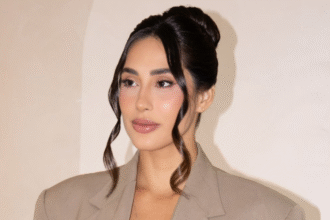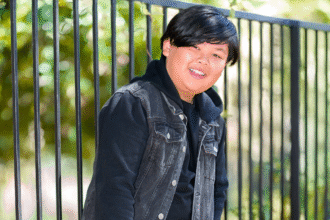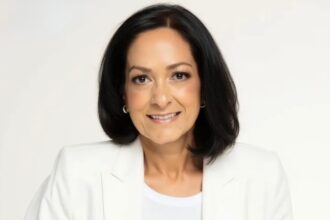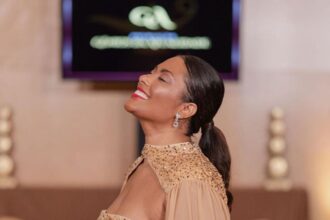Actress and activist Jacqueline Sato is expanding her screen presence and at the same time focusing on important causes. With a wide-ranging career, from series and soap operas to dubbing anime, Sato is now preparing to act in “A História Delas”, a new Star+ series, where she will share a scene with the likes of Letícia Spiller, Cris Vianna and others. In addition to her acting, the actress, who is also a presenter, will launch a programme on the E! channel called “Mulheres Asiáticas” (Asian Women), focused on representation and celebrating the diversity of Asian Brazilian women. Off screen, Jacqueline Sato is an environmental activist and ambassador for Greenpeace Brazil, getting involved in causes such as nature protection, the preservation of the Amazon and animal protection through her animal protection association, House of Cats. She is taking advantage of her position to raise awareness of urgent issues and give space to essential causes.
You’re involved in a variety of projects, from acting in series to television programmes. How do you balance these different creative fronts?
I feel that one thing complements the other, so when I’m active on one creative front, the other automatically benefits. I like to be free to experiment in different ways. I break through internal or external “limits” and surprise myself along the way. I try to be 100% present in whatever I’m doing and flow from one thing to the next, avoiding the pitfalls of excessive self-charging and doing one thing while thinking about another, or “wanting” another.
You are an ambassador for Greenpeace Brazil and have a strong presence in environmental activism. How do art and activism intertwine in your life and career?
They are two very strong and important presences for me. I can’t live without them. They’re an intrinsic part of who I am. I could say that they were both born in me. From a very young age, both my concern for nature and artistic expression were already evident in me. And the word intertwine is great, because one passes through the other and both contain the power to transform! Perhaps transformation is something that fascinates me. To this day, art and activism have gone hand in hand and intertwined. As an artist, I’ve always looked to nature for inspiration and understanding, and as an activist, I try to use my expression and knowledge of communication so that awareness can reach more people in a clear and impactful way. I’ve always tried to use the visibility I have to give a voice to important and urgent causes. And in the not too distant future, I want to carry out work that unites the two areas even more.
Your participation in “A História Delas” seems to bring a narrative involving female representation. What’s it like being part of this project and what’s your view of representation in the entertainment industry?
I’m very happy to be part of this series, which, as its name implies, centres on women’s stories. For so many years, the content was centred on male narratives. It’s so good to be able to have our voices authentically present in audiovisual works, as is the case with “Their Story”. It’s a project that takes representativeness seriously, takes sensitivity and care in choosing each character so as not to perpetuate stereotypes, and has representativeness both in front of and behind the camera. It was an immense pleasure and I’m really looking forward to watching it!
Now, my view of representation in the entertainment industry is that we are waking up. There’s still a long way to go, but there are already good signs of change here and there. For some time now, some professionals have woken up to the importance and richness of having plurality in their casts, crews, scripts, everything; others continue to repeat the old pattern. There’s still a long way to go before this industry is fair and embraces the multiplicity that is humanity. I think that those who are already awake and aware have to wake up those who are not yet acting in this direction. Those who are aware have to come together to bring about the transformation that is so necessary. And when we unite, we feel stronger. I like to remember that those of us who don’t feel properly represented are the majority, and by being united and aware we can act together in pursuit of what is right.

You were recently in the Amazon with Greenpeace. Could you share your experience with us and what motivated you to get involved with the environmental cause?
Yes, it was one of the most transformative experiences I’ve ever had. I’ve always been very connected to nature and its protection. I believe that my awareness of the importance of not only protecting it, but also finding ways to reduce the damage that we, as humanity, have already caused to it, was awakened when I was still a child. I remember hearing about the extinction of species and global warming and immediately realised that I wanted to do something about it. I almost studied environmental engineering, but my love of art and communication made me realise that I could also act through these other forms of work. And I’ve always known how much influence public figures have, so I chose this path of using visibility and communication to be an ally in this cause.
On this trip to the Amazon, for me, who has always defended it without knowing it in person, from afar, always imagining what it’s like, I fell backwards when I was “in it”. It is of indescribable magnitude. An abundance of life, species, trees infinitely larger than one could imagine, forms of life and society that broaden our view of existence. The forest is immense, but it’s shocking to think that it was once much bigger. And it’s shocking to think that because of the greed of a few, so much life is destroyed, with extremely serious consequences for all of humanity. Without human intervention, the beauty of this ecosystem works perfectly, a totally synchronised choreography that thrills and makes us want to protect this heritage of all of us even more.
I stayed in the community of Tumbira, a sustainable development reserve, which has experienced the transformation of their lives since they became part of the team that says with certainty that the standing forest is more profitable and beneficial for everyone now and in the future. To give you an idea, before, they had no market, no schools, no internet. Now, they have all this, the young people receive workshops in the most diverse areas to improve their skills, they have an incredible restaurant, and their income comes practically from tourism and the sale of artisanal products. It’s infinitely safer, more satisfying, more sustainable and more enjoyable than being dependent on logging, which unfortunately still happens in many communities.
As the presenter of the “Asian Women” programme, how important is it to highlight and give prominence to Asian Brazilian women in the media?
For me, it’s a paradigm shift. I grew up not seeing people who looked like me on TV. This can create an indescribable hole, pain and weakness. The lack of representation means that dreams are no longer considered possible. I myself have doubted countless times whether I could and would be able to pursue the career that I am so sure is my vocation. I persisted and continue to persist. But I know that many people don’t even try, others give up, and that’s very sad. Then, in the few situations where we see someone who somehow makes us identify with them, it’s often the features that are responsible for generating this, but not the character, because they’re stereotypical or so irrelevant to the plot that they don’t make anyone really connect. After 12 years in the business, a lot of watching and talking to professionals in the field, I came to the conclusion that the best way (within my reach) to change this limited “vision” of us would be through a programme that brought real women in front of the camera. I have faith that in this way, people will get to know how diverse we are, and in this way, we will contribute to a broader and more real collective imaginary of who so-called “Asian women” are.
You are the founder and CEO of House of Cats, an animal protection organisation. How did you start this project and how important is animal protection to you?
Ah, this is my oldest project (laughs). We say it started when I brought my first litter of cats home at the age of nine. And from then on, rescuing cats and offering them temporary homes until we found them permanent, responsible homes became the norm. Until the neighbourhood began to look up to us and I, at the same time, grew in my acting career, which led to many more animals being adopted. Today, we have 2,425 cats rescued, cared for and adopted. I get emotional when I stop to think that they are many lives transformed. The protection of animals is something that has always lived inside me, and I’m very happy to realise that I’ve been able to contribute in some way.

In your work as a voice actress in the anime “My Hero Academia: 2 Heroes”, what is the experience of voicing characters like and how do you prepare for this activity?
Oh, it was so cool! I love dubbing anime and animation in general. We can be daring and creative in ways that other types of content aren’t so much. Not everyone knows it, but in dubbing, you often arrive at the studio without even knowing which character you’re going to dub. You find out on the spot. And then the creation begins. It’s all very fast and fluid. Depending on the case, they’ll open up to you first, but that’s the exception. Not to mention the technical part, the care, the warm-up, the voice preparation, I think concentration and spontaneity have to be very active when it comes to recording. There’s no sequence of rehearsals, just a few passes and you’re recording. This makes it very challenging. Once I understood what the world of voice acting is like in practice, I began to admire voice actors even more.
In the series “The Absentees” and in other works, you deal with complex and emotional themes. How do you prepare yourself emotionally to play characters with intense stories?
Each character requires specific preparation. In some projects we even have a cast coach. This is marvellous, because in addition to the individual work as an actress, there is this exchange and suggestions for exercises that come from this professional. That’s always the best of all worlds, because you can delve into different points of view, which is always enriching. I love it when I have the opportunity to work on productions like this.
The first reading of the script is always very important to me. There, I connect with my intuition in an attentive way to see what emerges straight away. Then I do a sequence of exercises, based on various methods I’ve learnt over the course of my 14-year career. I like to experiment a lot on my own. To exhaust the possibilities that I can find on my own in the scene. But the truth is that it’s only born when you’re in a relationship with the “other”. So I memorise the lines in a neutral way, as I learned studying Meisner, because for me that’s the way the text is buried deepest inside me, and I’m open to what’s going to happen at playtime. This way of memorising leaves me with the greatest freedom to really be fluid and malleable for the “now”, and with the porosity to do each rehearsal with the other actor, and each take, in a unique way, being able to go through surprisingly different possibilities.
In general, I try to create this connection between myself and the character as deeply as possible, understanding their motivations, their greatest desires, their obstacles (internal and external), their personality traits (studying a bit of psychology always helps), and above all feeling all of this vividly in their bodies. Understanding rationally isn’t enough, you need to bring it into your body. And there are thousands of approaches, from the use of bioenergetic exercises to BodyMindMovement, among others. For each situation I choose what is most appropriate and possible.
The cool thing is when you’re already so close to the text and the character that you don’t even think about anything else, everything is already inside you. Sometimes it happens faster, sometimes it takes more dedication. But it’s only when it gets to that point that I consider myself “ready”.
What message or impact do you hope to convey to the public with the projects you’re involved in, both as an actress and as an activist?
If the work I’m involved in generates reflection and transformation in one person, I’m already happy. A human being who becomes more empathetic and more aware is able to multiply this in their surroundings, and so we each transform the whole in whatever way we can.
As an actress, it’s always been about loving human beings and wanting to understand and feel more deeply what we all are. When you understand the “other” better, you understand yourself better. When you really empathise, it’s so beautiful. Justice, kindness and connection become more present.
As an activist, it is undoubtedly about raising awareness of the context in which we are living and the possibilities that each person has to be part of the solution rather than the problem, to the extent that each person can at any given moment in their lives. Any small conscious change is extremely valuable, because it leads to another, and another, and encourages other people to take action too.
As a multifaceted artist, what’s the next big challenge you’d like to face in your career?
To be involved in projects that unite my two passions: art and nature. To be able to “tell stories” that can generate a positive impact, stories that carry the urgency of protecting nature as an important part of the narrative. But not only that, I also want to star in series and films that I’m very proud of without having to explain my “existence” in the plot because I’m yellow.
Follow Jacqueline Sato on Instagram





